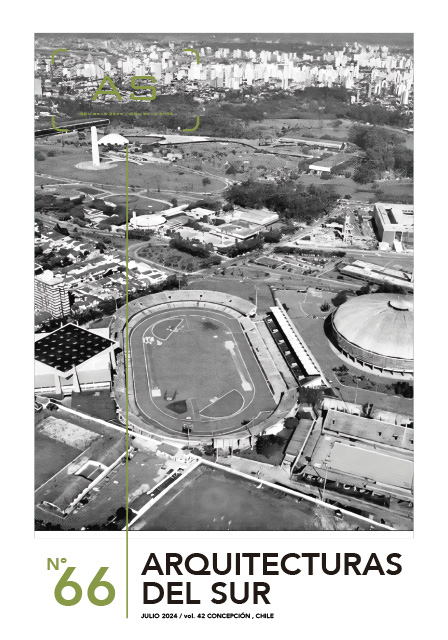Armonías numéricas en la educación arquitectónica: retícula Villard de Honnecourt
DOI:
https://doi.org/10.22320/07196466.2024.42.066.07Palabras clave:
retícula de Villard de Honnecourt, arquitectura medieval, educación arquitectónica contemporánea, herramientas digitales, proceso de enseñanza-aprendizajeResumen
El análisis de la retícula de Villard de Honnecourt y su rol en la arquitectura medieval ofrece una perspectiva enriquecedora para la educación arquitectónica contemporánea. Durante la pandemia de COVID-19, en el año xx, en la Universidad Autónoma de Ciudad Juárez, México, se implementó con éxito esta herramienta histórica. La elección estratégica de la retícula como punto de partida permitió explorar las técnicas constructivas medievales integradas con herramientas digitales. Este enfoque no sólo resalta la conexión entre arquitectura y música, evidenciando la influencia de la escuela Pitagórica y Platónica en la Edad Media sino que también, demuestra la versatilidad de la retícula en la formación académica. A través de análisis prácticos y estudios de caso, se promovieron habilidades analíticas y creativas entre quienes se dedican a estudiar arquitectura. La transformación de la enseñanza de la arquitectura en entornos universitarios actuales, alejándose del modelo tradicional, plantea desafíos. La disyuntiva entre herramientas digitales y acceso a la información permite reinterpretar métodos compositivos. El análisis del uso académico de la retícula de Villard de Honnecourt, y su predecesor la retícula Van Der Graaf, destaca su relevancia histórica y características geométricas distintivas. Desde sus orígenes medievales hasta su aplicación contemporánea, la retícula se consolida como una herramienta pedagógica esencial. Este estudio realizado en la Universidad Autónoma de Ciudad Juárez, reflexiona sobre el modelo propuesto por la retícula. Analiza sus implicaciones en los procesos de enseñanza-aprendizaje académico, revelando su impacto en dimensiones físicas, documentales y tecnológicas. En síntesis, destaca la adaptabilidad y relevancia continua de la retícula como herramienta pedagógica esencial en la formación de arquitectos.
Descargas
Citas
BARNES, C. F. (2009). The Portfolio of Villard de Honnecourt: A New Critical Edition and Color Facsimile. Farnham, Surrey: Ashgate Publishing Limited.
BERTOLA, R. (2015). El diagrama arquitectónico después de Deleuze: estudio de casos holandeses [Tesis Doctoral, Universitat Politècnica de Catalunya]. https://dialnet.unirioja.es/servlet/tesis?codigo=129368
BINSKI, P. (2012). Villard de Honnecourt and invention. Nottingham Medieval Studies, 56, 63-79. doi:10.1484/J.NMS.1.102752
BOWIE, T. R. (1959). The sketchbook of Villard de Honnecourt. University: distributed by G. Wittenborn.
CANVA. (2022) Editor de fotos y videos (número de versión ej: 2.1)[Aplicación móvil]. Google Play. https://www.canva.com/es_es/
EGGERS, C. (2005). Platón- Timeo. Colihue.
EGIDO JIMÉNEZ, H. (2018). Del tiempo al espacio. Diccionario gráfico comparado entre música y arquitectura [Tesis de grado, Universidad Politécnica de Madrid]. https://oa.upm.es/50857/
FOUCAULT, M. (1966). Las palabras y las cosas: Una arqueología de las ciencias humanas. Siglo XXI Editores.
Gamma. (2024). Gamma.app . [Aplicación móvil]. Google Play. https://gamma.app/docs/La-reticula-de-Villard-de-Honnecourt-y-sus-alcances-teoricos-prac-96vfimw2fyatfp2?mode=doc: https://gamma.app/
Genially. (2022). Experiencias interactivas . [Aplicación móvil]. Google Play. https://genially.com/es/
HAHNLOSER, H. R. (1972). Villard de Honnecourt Kritische des Bauhüttenbuches fr 19093 der Pariser Nationalbibliothek: Akademische Verlagsanst.
HASLAM, A. (2006). Bookdesign: A comprehensive guide. Abrams. https://archive.org/details/bookdesign0000hasl
HONNECOURT, V., LASSUS, J. B., & DARCEL, A. (1968). Album de Villard de Honnecourt, architecte du XIIIe siècle: manuscrit publié en fac-similé, annoté, précédé de considérations sur la renaissance de l'art français au XIXe siècle et suivi d'un glossaire. https://archive.org/details/bnf-bpt6k6212475p/page/n11/mode/2up
INNERARITY, D. (2023). El sueño de la máquina creativa. https://www.danielinnerarity.es/opini%C3%B3n-preblog-2023/el-sue%C3%B1o-de-la-m%C3%A1quina-creativa/
KRUFT, H.-W. (1994). A history of architectural theory: From vitruvius to the present. Princeton Architectural Press.
MURRAY, S. (2014). Plotting Gothic: A Paradox. Architectural Histories, 2(1), 16. https://doi.org/10.5334/ah.bs
O’CONNOR, J. J., & ROBERTSON, E. F. (28 de octubre de 2005). “Real Numbers 1.” Maths History. https://mathshistory.st-andrews.ac.uk/HistTopics/Real_numbers_1/
SÁNCHEZ MUÑOZ, J. M. (2011). Las Escuelas Jónica y Pitagórica. Revista de Investigación, G.I.E. Pensamiento Matemático. ISSN 2174-0410.
SIFUENTES-SOLIS, M. A. y TORRES-LANDA, A. (2014). La E-A de la "Historia de la arquitectura" en las IES de la era digital: hacia una nueva e-topía. Revista Iberoamericana de Educación, Instituto de Investigaciones sobre la Universidad y la Educación México, 117-141. http://www.redalyc.org/articulo.oa?id=299130713008
WILLIS, R. (1859). Facsimile of the sketch-book of Wilars de Honecort, an architect of the thirteenth century: illustrated by commentaries and descriptions. John Henry and James Parker. https://archive.org/details/facsimileofsketc00vill/page/n7/mode/2up
Descargas
Publicado
Cómo citar
Número
Sección
Licencia
Derechos de autor 2024 Elian Coral Moreno-Sánchez

Esta obra está bajo una licencia internacional Creative Commons Atribución-CompartirIgual 4.0.
El contenido de los artículos que se publican en cada número de Arquitecturas del Sur, es responsabilidad exclusiva de los autores y no representan necesariamente el pensamiento, ni comprometen la opinión de la Universidad del Bío-Bío.
Las/os autoras/es conservarán sus derechos de autoría, sin embargo, garantizarán a la revista el derecho de primera publicación y difusión de su obra. La publicación del artículo en Arquitecturas del Sur está sujeta a la Licencia de Reconocimiento de Creative Commons CC BY-SA que permite a otros Adaptar: remezclar, transformar y construir sobre el material para cualquier propósito, incluso comercialmente, Compartir: copie y redistribuya el material en cualquier medio o formato, siempre y cuando se reconozcan la autoría y la primera publicación en esta revista citando correctamente, así como también sus nuevas creaciones estén bajo una licencia con los mismos términos.













 Programa de Información Científica/Concurso Fondos de Publicación de Revistas Científicas 2018/ Proyecto Mejoramiento de Visibilidad de Revistas UBB (Código:FP180007)
Programa de Información Científica/Concurso Fondos de Publicación de Revistas Científicas 2018/ Proyecto Mejoramiento de Visibilidad de Revistas UBB (Código:FP180007) 
